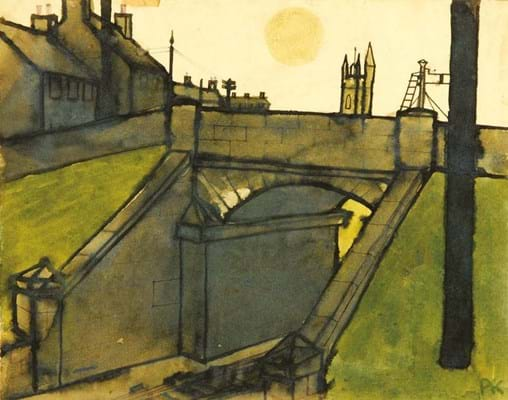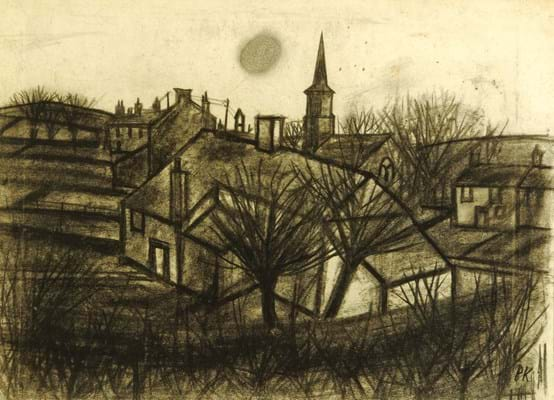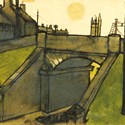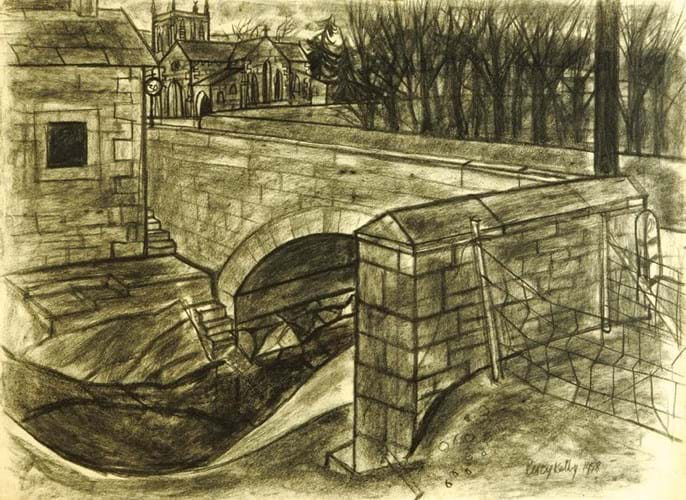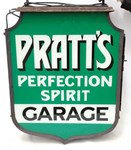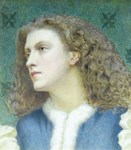Kelly used linear, graphic and simple compositions to depict his views of the Lake District and the industrial towns and villages of his native west Cumbria (quite the opposite to the chocolate-box views of the region some of his contemporaries were painting at the time).
A prolific artist who suffered acute bouts of loneliness and depression, he produced thousands of pictures in a variety of media, including watercolour and charcoal.
He also wrote numerous illustrated letters to friends, many containing drawings and paintings of his beloved Cumbria.
‘PK’ was born into a lower-class existence in Workington. It is said he could hold a pencil before he could walk and would draw every day and on anything he could find, including plastic plates and cereal boxes.
He first pursued a career as a postman, occasionally drawing on the letters he had to deliver, but it was after a period at the War Office during the Second World War that he took to art.
After leaving Cumbria, he continued to paint pictures of the towns, villages and fells of the county, as well as scenes from Pembrokeshire, Cornwall and Norfolk.
Rediscovered talent
For many years Kelly rarely showed or sold any of his pictures, preferring to live in poverty.
Several notable UK galleries, Agnew’s and Crane Kalman among them, tried and failed to persuade him to exhibit.
“They are so important to me I could never sell them,” he once said. It was not until after his death, when a vast body of work was found in his Norfolk cottage, that his reputation began to grow helped along by solo exhibitions at Castlegate in Cumbria and Messum’s in London.
Cumbrian saleroom Mitchells (20% buyer’s premium) of Cockermouth regularly offers Kelly’s artworks on the secondary market.
The local auction house benefits from its proximity to the artist’s biggest market – Cumbria-based collectors – and to date more than 350 works have passed through its doors.
This includes Loweswater Church, a large watercolour that sold in 2016 for £6000, which is believed to be the highest sum paid for the artist’s work at auction.
Prior to that, few pictures had made more than the £4000 (with fees) paid for a view of the Cumbrian town of Kendal at Christie’s South Kensington in 2013.
In September 2015, the saleroom was also tasked with selling 140 ‘painted letters’ from Kelly to Mary Burkett, former director of Abbot Hall Art Gallery in Kendal and well-known champion of artists in north-west England. These were eagerly contested and helped generate over £84,000.
Since then, Mark Wise, director at Mitchells, says he has seen another rise in demand for Kelly’s work, particularly in the last year.
“I thought his works had reached a high three or four years ago, but recent interest in him, like the big retrospective [at Tullie House Museum] in Carlisle and from the media, has meant that those few that have come onto the market here in the last 12 months have done exceptionally well and far better than I had ever expected.”
Collectors who were buying 10 years ago “have made a very good investment”, he added.
Cockermouth sale
In Mitchells’ latest offering – a three-day sale on June 12-14 in Cockermouth – five of Kelly’s pictures were included, consigned from two separate sources.
Two or three bidders local to the auction house competed for each lot, with the group divided equally between them to total £17,000.
Kelly’s charcoal drawings of Cumbria produced in the late 1950s-60s are generally considered his best works, and it was from here that the most expensive works came.
The first, a large 21in x 2ft 5in (53 x 73cm) charcoal view of an unspecified Cumbrian village, its skyline dominated by a church spire, led the way at £4200, more than double its top guide.
It was described in the catalogue as in ‘generally good condition’ with some faint foxing and spots but ‘could be hung and enjoyed in its current state without the need for any work’.
Coming in a close second was a marginally larger 22in x 2ft 6in (56 x 76cm) West Cumbrian view of a church by a bridge, dated 1958. Against an identical £1500-2000 estimate, it was knocked down at £4100.
While these drawings were predicted to make the most money, said Wise, the high level of interest shown for the three “less typical and more representational” early watercolours that followed was unexpected. They were consigned from another local source with lower estimates ranging from £400-800.
The smallest and boldest showed a railway bridge in Aspatria – the town where fellow Cumbrian painter Sheila Fell was born – and, unlike the other two, contained Kelly’s trademark strong black lines. Glued on board, the 8 x 10in (20 x 26cm) watercolour sold for a punchy £3400.
Completing the group
It was close in composition to a later 1960s work, Bridge in Winter, which sold for £3000 at Christie’s South Kensington in March 2015. That work was executed in oils, a rarity in the artist’s oeuvre because his first wife, Audrey, supposedly could not bear the smell of linseed and turpentine.
Completing the group were a 10 x 19in (24 x 48cm) watercolour of a Cumbrian village, dated 1949, and a 11 x 13in (28 x 34cm) street view of Kirkgate in Cockermouth. They made £3100 and £2200 respectively


